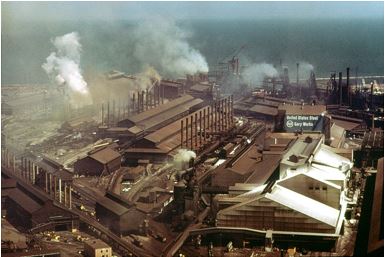Unequal Carbon Footprints
compare your own carbon emissions with some of the largest emitters in the US
The Steel Industry and Greenhouse Gas Emissions
All Text from: Environmental Protection Agency (2016). Inventory of U.S. Greenhouse Gas Emissions and Sinks: 1990-2014.
Iron and steel production is a multi-step process that generates process-related emissions of carbon dioxide (CO2) and methane (CH4) as raw materials are refined into iron and then transformed into crude steel….Iron and steel production includes six distinct production processes: coke production, sinter production, direct reduced iron (DRI) production, pig iron production, electric arc furnace (EAF) steel production, and basic oxygen furnace (BOF) steel production. The number of production processes at a particular plant is dependent upon the specific plant configuration. In addition to the production processes mentioned above, CO2 is also generated at iron and steel mills through the consumption of process byproducts (e.g., blast furnace gas, coke oven gas) used for various purposes including heating, annealing, and electricity generation…In general, CO2 emissions are generated in these production processes through the reduction and consumption of various carbon-containing inputs (e.g., ore, scrap, flux, coke byproducts). In addition, fugitive CH4 emissions can also be generated from these processes but also sinter, direct iron and pellet production.
Currently, there are between 15 and 20 integrated iron and steel steelmaking facilities that utilize BOFs to refine and produce steel from iron and more than 100 steelmaking facilities that utilize EAFs to produce steel primarily from recycled ferrous scrap. In addition, there are 18 cokemaking facilities, of which 7 facilities are co-located with integrated iron and steel facilities. Slightly more than 62 percent of the raw steel produced in the United States is produced in one of seven states: Alabama, Arkansas, Indiana, Kentucky, Mississippi, Ohio, and Tennessee (AISI 2015a).
Total production of crude steel in the United States between 2000 and 2008 ranged from a low of 99,320,000 tons to a high of 109,880,000 tons (2001 and 2004, respectively). Due to the decrease in demand caused by the global economic downturn (particularly from the automotive industry), crude steel production in the United States sharply decreased to 65,459,000 tons in 2009. In 2010, crude steel production rebounded to 88,731,000 tons as economic conditions improved and then continued to increase to 95,237,000 tons in 2011 and 97,770,000 tons in 2012; crude steel production slightly decreased to 95,766,000 tons in 2013 and then slightly increased to 97,195,000 tons in 2014 (AISI 2015a). The United States was the third largest producer of raw steel in the world, behind China and Japan, accounting for approximately 5.3 percent of world production in 2013 (AISI 2015a).
The majority of CO2 emissions from the iron and steel production process come from the use of coke in the production of pig iron and from the consumption of other process byproducts, with lesser amounts emitted from the use of flux and from the removal of carbon from pig iron used to produce steel. According to the 2006 IPCC Guidelines (IPCC 2006), the production of metallurgical coke from coking coal is considered to be an energy use of fossil fuel and the use of coke in iron and steel production is considered to be an industrial process source. Therefore, the 2006 IPCC Guidelines suggest that emissions from the production of metallurgical coke should be reported separately in the Energy sector, while emissions from coke consumption in iron and steel production should be reported in the Industrial Processes and Product Use sector. However, the approaches and emission estimates for both metallurgical coke production and iron and steel production are both presented here because much of the relevant activity data is used to estimate emissions from both metallurgical coke production and iron and steel production. For example, some byproducts (e.g., coke oven gas) of the metallurgical coke production process are consumed during iron and steel production, and some byproducts of the iron and steel production process (e.g., blast furnace gas) are consumed during metallurgical coke production. Emissions associated with the consumption of these byproducts are attributed at the point of consumption...
Metallurgical Coke Production
Emissions of CO2 from metallurgical coke production in 2014 were 1.9 MMT CO2 Eq. (1,938 kt CO2) (see Table 4-57 and Table 4-58). Emissions increased in 2014 from 2013 levels, but have decreased overall since 1990. Domestic coke production data for 2014 are not yet published and so 2013 data were used as proxy for 2014. Coke production in 2014 was 26 percent lower than in 2000 and 45 percent below 1990. Overall, emissions from metallurgical coke production have declined by 23 percent (0.6 MMT CO2 Eq.) from 1990 to 2014.

Iron and Steel Production
Emissions of CO2 and CH4 from iron and steel production in 2014 were 53.4 MMT CO2 Eq. (53,417 kt) and 0.0094 MMT CO2 Eq. (0.4 kt), respectively (see Table 4-59 through Table 4-62), totaling approximately 53.4 MMT CO2 Eq. Emissions decreased in 2014 and have decreased overall since 1990 due to restructuring of the industry, technological improvements, and increased scrap steel utilization. Carbon dioxide emission estimates include emissions from the consumption of carbonaceous materials in the blast furnace, EAF, and BOF, as well as blast furnace gas and coke oven gas consumption for other activities at the steel mill. In 2014, domestic production of pig iron decreased by 3 percent from 2013 levels. Overall, domestic pig iron production has declined since the 1990s. Pig iron production in 2014 was 39 percent lower than in 2000 and 41 percent below 1990. Carbon dioxide emissions from steel production have decreased by 4 percent (0.3 MMT CO2 Eq.) since 1990, while overall CO2 emissions from iron and steel production have declined by 45 percent (43.7 MMT CO2 Eq.) from 1990 to 2014 (pp. 4-56-4-59).
 Profile of the largest emitter in the industry: the U.S. Steel Corporation Gary Works in Gary, Indiana.
Profile of the largest emitter in the industry: the U.S. Steel Corporation Gary Works in Gary, Indiana.
